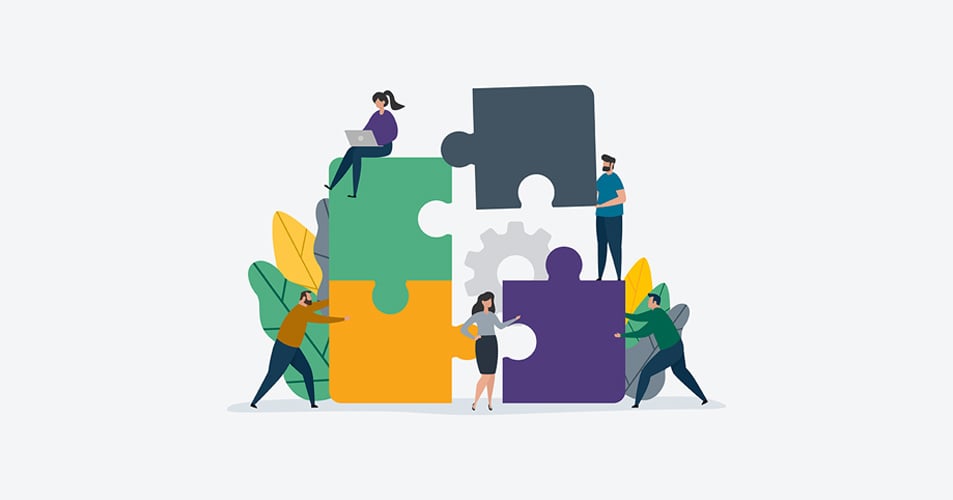
Many leaders assume efficiencies achieved from generative AI investments involve the removal of the human element. And though generative AI can automate and streamline a wide range of tasks, that’s not quite right. In fact, successful efforts very much require human collaboration — stakeholders aligning to set strategic goals, define deliverables and determine performance metrics and KPIs.
The secret to optimizing Generative AI investment isn’t necessarily more and better technology — it’s ensuring stakeholders are equipped to leverage the powerful technology in executing their workflows and collaborating with their colleagues.
Anyone that works in a matrixed organization is all too familiar with the friction that comes with endless multi-stakeholder reviews and alignment cycles. Against this backdrop, organizations are rushing to invest in generative AI to increase efficiency and productivity. But to reap these benefits, leaders must think further ahead than technology adoption. Given the well-known challenges with previous waves of digital transformation (some estimate the failure rate to be 84%) , organizations will need to focus on how AI will impact workflows and equip people — that’s right, actual humans — to adapt to the organizational impacts of the efficiency promised by this technology.
First, let’s take a brief look at a typical workflow in a large organization today:
- An individual contributor (IC) is directed to develop a deliverable and goes “heads down” on the task. Example: A software engineer writing code or a consultant creating a client deck.
- Upon completion, their work product goes through a cycle of stakeholder review, revision, and alignment of decisions and next steps, including feedback from peers, direct and second line managers, and cross-functional stakeholders. This stage is often the more time-consuming and difficult task given the need to balance competing priorities, incentives, timelines, budgets, and sometimes difficult personalities. Example: A software engineer interacts with product managers, project managers, Legal and Compliance, etc.; a consultant interacts with project teammates, project leads, and clients.
- This cycle of stakeholder review, revision, and alignment may occur once or repeat for several iterations until the product is shipped or the decision is implemented.

Now consider the impact that generative AI is going to have on that common workflow.
Many generative AI applications are aimed at delivering efficiencies at the individual contributor level of work activities. A recent study at the consulting firm BCG found that consultants with access to generative AI were 25% more efficient in completing select tasks when leveraging the technology. Another study found that programmers with access to GitHub Copilot were able to implement an HTTP server in JavaScript 56% faster than developers without access to AI. Taken together, these studies indicate that generative AI has a positive impact on individual contributor efficiency across a broad range of knowledge worker roles.
These gains may seem to produce the quick efficiency wins promised, but few individual contributors are able to effect change in an organization unilaterally. The cross-functional stakeholders still need to review, discuss, negotiate, influence, communicate, and align around the work product being created by AI-assisted individual contributors. Many organizations already struggle with this as they may not be structured to make faster decisions, or their individual contributors don’t appreciate the necessity of these skills. (Pop quiz: How many software engineers believe negotiation to be in their job description?).
As individual contributors become more efficient in shipping their work product, cross-functional stakeholder alignment cycles will increasingly become the bottleneck in workflows as they are inundated with inputs demanding rapid review and feedback (figure 2). Individual contributors may benefit from the AI investments, but the managers and cross-functional review teams they depend on will be overwhelmed as the backlog grows - and the substantial investments the organization made in AI will fail to produce the efficiency outcomes they expected. 
The organizations at the front of the adoption curve in AI investments will be the first to experience these challenges, which are inherently lagging indicators. You’ll know your organization is starting to feel the pain from this dynamic at multiple levels:
- Individual Contributors will spend more time in meetings and shared documents than on heads down tasks. Utilization rates will decrease as they wait for cross-functional steers and morale will crater as they worry about their ability to quickly deliver and drive value.
- Cross-functional teams will receive blame for acting as bottlenecks as they try to keep up with the pace. This dynamic will strain and damage working relationships and cause more churn in alignment cycles.
- Managers will face more frequent escalations to compensate for cross-functional team bottleneck, causing them to make poorer decisions as they prioritize speed over quality. This will result in poor business outcomes and deferred costs from having to backtrack and do damage control.
- Organizations will fail to realize the efficiency gains they forecasted when justifying the large AI investments, frustrating employees and undercutting management. They will have to explain to shareholders why their expensive investments have not manifested in the promised value.
- Training the entire organization to negotiate and influence within and across teams more effectively.
- Enabling all employees (horizontally and vertically) to present their ideas and work product more effectively and communicate for better understanding.
- Creating a culture that prioritizes building durable and healthy work relationships and requires the effective and efficient conduct of meetings and interactions.
- Designing adaptive cross-functional teams and work processes.
- Clarifying roles and responsibilities, pushing decision-making authority further down the organization.
- Aligning individual incentives to those of the broader organization.

If organizations want to fully realize the productivity gains from their AI investments (without cutting IC roles or hiring additional cross-functional review or manager roles), they must simultaneously improve their organization’s capacity for stakeholder alignment.
Generative AI will, and already has, changed the future of work in both expected and unexpected ways. Even with significant technological advancements, humans will always have to come together to collaborate, align, and advance their business objectives.
Leaders must initiate proactive measures to build the mindsets, behaviors, and processes needed to successfully align around — and implement — AI initiatives. Without this human alignment, organizations joining the AI revolution will be doomed to repeat the failure rates of digital transformations that have come before.
About the Author
Logan Kessler is the Director of Business Transformation at Vantage Partners, a consulting firm that helps clients align key stakeholders in order to advance critical business objectives. Mr. Kessler received an MBA from Berkeley Haas and an MALD from the Fletcher School of Internation Affairs.
.png?width=512&height=130&name=vantage-logo(2).png)

